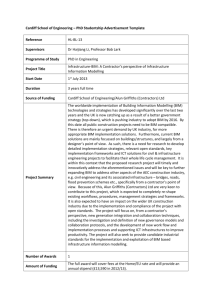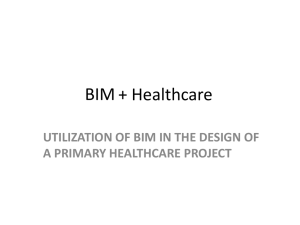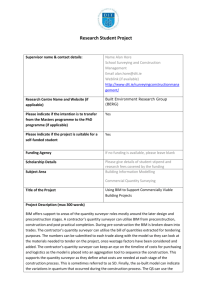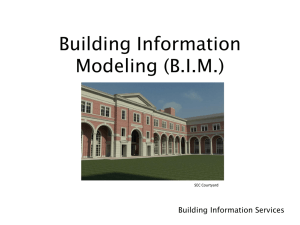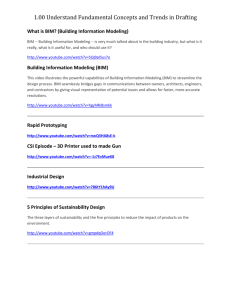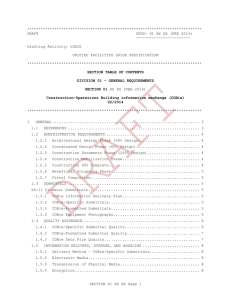INFORMATION ON LANDSCAPE BIM - Planning & Building Control
advertisement
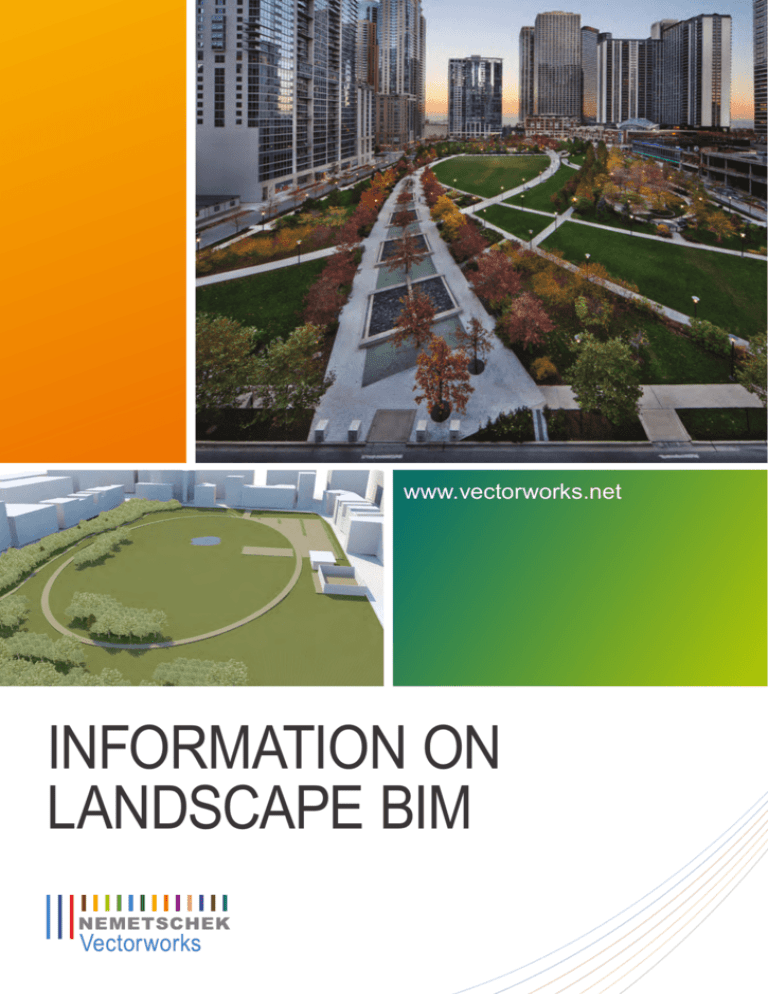
www.vectorworks.net INFORMATION ON LANDSCAPE BIM INFORMATION INNOVATION INON LANDSCAPE BIM BIM VECTORWORKS BIM & CAD SOFTWARE FOR LANDSCAPE ARCHITECTURE • GARDEN DESIGN • URBAN PLANNING Courtesy of the Office of James Burnett GETTING OUR BIM DATA IN ORDER To paraphrase the former Chief Construction Advisor to the UK Government, Paul Morrell, BIM is an opportunity for the construction industry to get its data in order. Of course BIM is a lot more than that and the ability to create models of building and landscape projects in the virtual world prior to construction offers all sorts of benefits such as design analysis, clash detection, previsualisation and increased levels of automated design documentation, but in this article I want to talk about data or information, the I in BIM. The UK Governments BIM Mandate for Level 2 is fast approaching and the provision of data in a standard known as COBie is an important aspect of that mandate. THE UK GOVERNMENT BIM LEVEL 2 MANDATE AND COBIE The ability to attach or embed data to virtual 2D or 3D geometry is not new. For exampIe, I have been working with Nemetschek Vectorworks since the mid 90’s and even back then it was we are trying to agree common data standards throughout the lifecycle of a project chain. This involves the multiple tiers of the supply chain, the consultants, architects, landscape architects, designers, the contractors, facilities management consultants and the client. Such a big project, will take time and to be successful, it will be necessary to tackle it in a number of stages. This is precisely the approach of the UK Government and the BIM Level 2 Mandate for 2016. One of the aspects of this mandate is the ability to deliver COBie compliant data. As described by Bill East “COBie is the list of all the managed and maintained assets in a building.” He goes on to say, that “the data delivered matches the information provided on the design schedules”. With my Landscape Institute hat on, I would substitute ‘building’ with project, in order to encompass wider industries such as Landscape and Infrastructure. Many commentators incorrectly refer to COBie primarily as a spreadsheet. It is more accurate to describe it as a data set which corresponds to a common standard, which can, if so desired, be presented in a spreadsheet format or which can also reside in a database. The important aspect is that the data corresponds to a common standard. WHY IS COBIE CRITICISED? possible to assign data to objects in order to automatically generate schedules, reports and bills of quantities. The problem with working in any software of the time was that due to a lack of data standards, almost every project, certainly every practice, used different sets of data, which typically evolved idiosyncratically over a number of years. The difference with the BIM evolution is that collectively, as an industry, To make my position clear, I think COBie is a good thing, bit it does come in for some criticism. Often, I hear the general term, ‘It doesn’t work’. This is generally unhelpful and simply leads to increased levels of what my colleague Robert Anderson, refers to as ‘FUD’, in other words fear, uncertaintly and doubt. Having said which, there are a few factors which can lead to COBie failing. First is the misunderstanding that the full COBie dataset needs to be completed at the outset of the project. This misapprehension leads to consultants involved in the design stages to complain that their creativity is being stifled. The reality is that COBie can be completed in stages and the data is built up over time reflecting the level of resolution and detail of the design in progress. In the CIC Digital Plan of Work, there are several formal ‘data drops’ ie designated points in the design process where a data exchange takes place between the various members of the project team. The early COBie data drops contain little more than a confirmation of the brief and schedules of the conceptual spaces, zones and areas of the building, site and landscaping. These are easily produced from today’s BIM software. It is only during the later COBie data drops that an additional refined dataset is required. At these stages, COBIe requires a listing of the types of object used within the project, followed by individual components of the design and then the specific manufacturer and supplier. The requirement to provide product manufacturer details leads to the second misapprehension about COBie – that of product attributes. COBie allows for product attributes to be supplied at the later stages of the project. There are two questions to consider here. Firstly, where does the designer get this information from and secondly, is it necessary to provide a complete product data specification for each object within the BIM? To address the first question, let’s be clear, it is not the intention of COBie, to place the burden of data input onto the shoulders of the architect designer. Instead, this will be fulfilled by the development and implementation of common industry standards for product specification. Initially called SPie in the US (Specifiers’ Properties information exchange), this has evolved in the UK into what we know as Product Data Templates (PDTs) and Product Data Sheets (PDSs) – simply put, these are common templates (PDTs ) supplied by the respective industry institutions (such as CIBSE, Landscape Institute) which provide a common set of data fields – they are templates because at this stage they contain only the field names but no actual data. These templates are then filled out by each manufacturer, and supplied to the design team in the form of Product Data Sheets or preferably, digital models embedded with the same common Product Data Information. Various organisations such as CIBSE and the Landscape Institute are working on these data templates as we speak and we are currently in a period of consultation with manufacturing organisations and the manufacturers themselves. Another interesting development on this side is the formation of a BuildingSMART group including representatives from ARUP, Nemetschek Vectorworks, RIBA NBS, the Landscape Institute and the BRE, in addition to several international organisations are looking specifically into how these data templates will fit into the open BIM standard of IFC. It is fair to say this is an evolving process and with this in mind it is important that when COBie is requested at the outset of a project, the Attributes section of the COBie dataset is considered carefully at this point in time. This is where is becomes critical to have both a BIM Execution Plan (BEP) and an Employers Information Requirement (EIP) document in place at the outset of the project. To address the second question, as to whether it is necessary to supply a complete product specification for each object within the BIM, the current consensus would suggest that it is not. Instead, we need to think about a number of aspects, what information is required to make an informed decision about which product to use in the design, what information needs to be supplied in order to construct the project, what information will be required to maintain the project and what information are the manufacturers able to provide. The Product Data Templates and Sheets project outlined above will, I believe go a long way to answering these questions and it will be very interesting to see how this aspect of the BIM process evolves to help us collaborate together effectively and get our data in order. Martyn Horne Landscape Institute BIM Working Group Nemetschek Vectorworks UK mhorne@unlimited.com BIM & CAD SOFTWARE FOR LANDSCAPE ARCHITECTURE • GARDEN DESIGN • URBAN PLANNING THE CLOCK IS TICKING… ARE YOU READY FOR BIM? Vectorworks Designer - Supporting Building Information Modelling workflows from concept through completion By January 2016, everyone working in the UK Landscape and construction sector needs to understand the potential of Building Information Modelling (BIM) and how they can use it to produce better quality buildings and landscapes more efficiently. For 25+ years, Nemetschek Vectorworks Inc has been a global leader in design technologies providing elegant architectural, landscape and lighting design software that offers Building Information Modelling (BIM) capabilities in a flexible, hybrid-design environment. Act now and contact us to make sure you are ready for BIM. Book a BIM Seminar for Landscape Architects 3ddesign@unlimited.com Associations we work with include the following: For more information on Vectorworks: visit www.bimvectorworks.com or call 020 8358 6668




